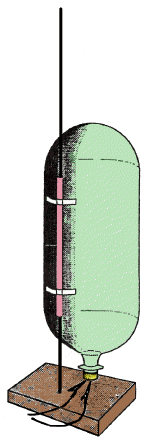Subject: Rocketry
Topic: liquid propelled rocket.
Description: A flyable liquid-propelled rocket is made from a plastic 2 liter soda pop bottle.
Contributed By: Gregory Vogt, OSU
EDITED BY: Roger Storm, NASA Lewis Research Center

Refer to cautions in the discussion section.
Upon ignition, the liquid propellant bottle rocket rises about 15 to 20 feet into the air with a very audible whoosh from the rocket's exhaust. Because the lighter fluid or naptha has been converted into a fine spray, much of the fluid in the bottle ignites immediately. Each tiny droplet of naptha provides a large burning surface for its volume consequently making ignition much more rapid than would have taken place if large drops of naptha were ignited.
The liquid propelled space rocket works on this very principle. Liquid propellants from tanks inside the rocket casing are pumped to the combustion chamber of the engine. Injectors, the rocket equivalent of shower spray nozzles, spray combustible mixtures of the propellants into the chamber where they are ignited. The rapid burning of the spray produces high gas pressure inside the chamber because of the expansion of the gas products during combustion. The expanded gas escapes through the engine nozzle and creates a powerful thrust.
The liquid propelled bottle rocket rises quickly off the launch pad to an altitude of as much as 20 feet before drag with the air produces a tumbling motion and stops its upward progress. After the first flight the bottle is crumpled because the plastic is heated, but not burned through, by the combustion inside. Cool outside air cannot flow back into the bottle as quickly as the combustion products that left through the nozzle. Outside air pressure squeezes the bottle and creates permanent dents. The bottle is still usable for several flights because additional ignitions reshape the bottle as pressure inside increases.
Caution: As with any demonstration involving fire, be careful to keep away from the rocket a safe distance before igniting it. A distance of 10 feet is sufficient. Do not over pressurize the bottle by spraying more than 2 times per launch or experimenting with smaller diameter nozzle holes. If the rocket does over pressurize, the aluminum bottle cap will be blown off the bottle downward with a startling sound. The bottle itself is surprisingly strong. Discard the rocket and make a new one. it is recommended that students not be told what the liquid propellant is. Refer to it as "special rocket fuel only teachers can get."
GO
BACK TO THE ROCKET ACTIVITIES
Aviation and Space Education News Oklahoma State University